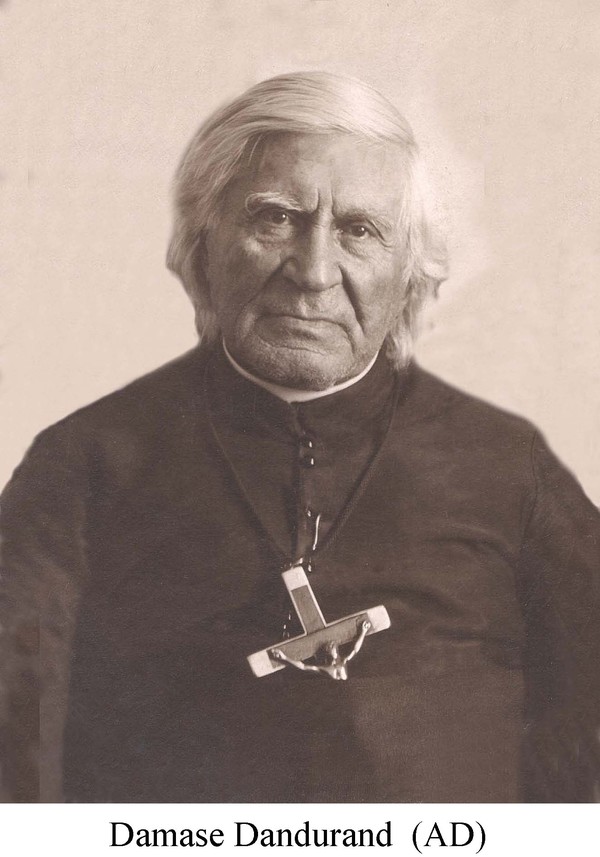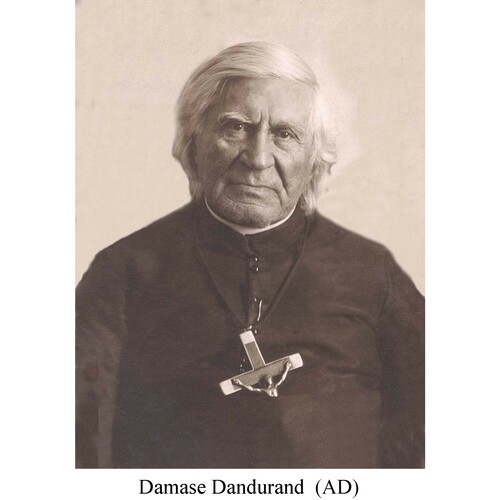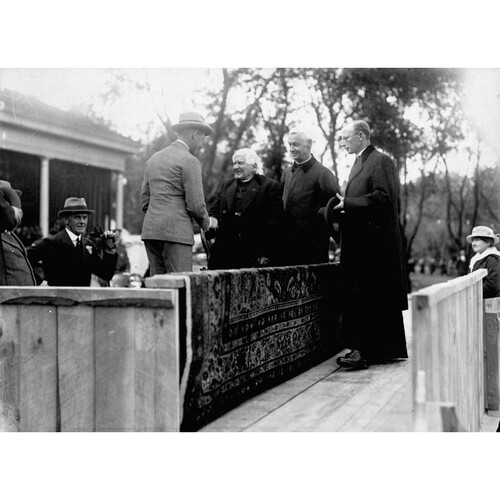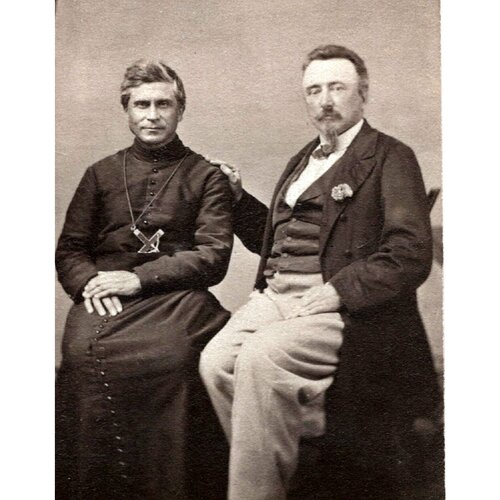
Source: Link
DANDURAND, DAMASE, first Canadian-born Oblate of Mary Immaculate, architect, and vicar general; b. 23 March 1819 in La Prairie, Lower Canada, son of Roger-François Dandurand, a notary, and Marie-Jovite Descombes-Porcheron; d. 13 April 1921 in St Boniface (Winnipeg).
The father of Damase Dandurand died on 14 Dec. 1821, and on 15 June 1825 his mother married Pierre-Paul Démaray*, a notary. Damase first attended an English school in Montreal, boarding with his uncle Gordon Forbes, who inspired in him a taste for construction and architecture. He thus acquired a good knowledge of English, which would prove indispensable in his future responsibilities. He then moved to Saint-Jean (Saint-Jean-sur-Richelieu), where his mother now lived. Because of his delicate health, he continued his schooling with private tutors up to the fifth year (Belles-Lettres) of the classical program. From 1832 to 1835 he finished his classical studies at the Collège de Chambly.
At 16, Dandurand chose to become a priest. He began teaching at the Collège de Chambly while studying theology there. His remarkable precocity is evidence of his above-average talent. Summoned to Montreal in 1840, he spent some time at the Grand Séminaire and is believed to have been in the service of Bishop Charles-Auguste-Marie-Joseph de Forbin-Janson*, who was then in Canada. By special permission because of his age, he was ordained a priest on 12 Sept. 1841 by Bishop Rémi Gaulin* of Kingston. On 2 December six Oblates of Mary Immaculate arrived from France at the request of Bishop Ignace Bourget* of Montreal to their founder, Bishop Charles-Joseph-Eugène de Mazenod of Marseilles [see Jean-Baptiste Honorat*].
Dandurand immediately thought of joining their order. He began his noviciate on 24 December and pronounced his vows at Christmas the following year. From then on he took part in many missions and retreats in the diocese of Montreal and even across the American border. He was particularly in demand in areas where English-speaking Catholics were present. In early 1844 he made two extensive tours through the Eastern Townships, including Stanbridge, Dunham, Granby, and Stanstead. In May, shortly after the Oblates had been put in charge of the Catholic mission in Bytown (Ottawa), he was called to serve the Irish community there, but when Father Michael Molloy, a true son of Ireland, arrived the following year, he resumed preaching in the diocese of Montreal.
Recalled to Bytown in 1847 because of the typhus epidemic raging there, Dandurand contracted the disease after a few weeks, and he would always remember this episode with horror. Soon after his recovery, Joseph-Bruno Guigues*, an Oblate who was now bishop of the diocese of Bytown, appointed him curé of the parish of Notre-Dame, where he was in charge from 1848 to 1874. Over the years he contributed to the construction of the cathedral, begun in 1841, by correcting the arrangement of the windows on the side walls. (He replaced a row of superposed windows with one of large windows.) He also erected the two towers and added a deep apse to the nave, all in Gothic style from his own plans. A generous and enterprising priest, he participated in the developments that enabled the ill-reputed village of Bytown to achieve the status of capital city. In particular, he supported the teaching and charitable work of the women who became the Sisters of Charity of Ottawa [see Élisabeth Bruyère*] by directing to them some of the parishioners’ charitable donations and by guiding towards them young women in search of their future. He reportedly also obtained the assistance of the Brothers of the Christian Schools. On various occasions Dandurand was appointed administrator of the diocese in the absence of the bishop, and he became his vicar general in 1862.
Some of Dandurand’s religious superiors, including Father Florent Vandenberghe, suspected that Bishop Guigues did not always respect the interests of his own congregation. Worried also about the legal implications of the vicar general’s administration, they decided in 1870 to put an end to the agreement of 1856 which had defined the role of the Oblates in Ottawa, but they let Dandurand remain in the service of the diocese. Although he had experienced conflictual situations, he was by no means an ideologue. He had rather kept in step with the thinking of his bishop, whose pastoral letters (very likely written by others) showed strong ultramontane overtones, but whose administration was marked by realism and compromise.
When Guigues died on 8 Feb. 1874 Dandurand became administrator of the diocese, according to the wishes of the former bishop, who had also mentioned him as his most appropriate successor. “He has been my right hand, my support, my consolation, my other self,” he had written a few months earlier. But the Oblates objected to the appointment of one of their number, and furthermore, there were differences of opinion with regard to Dandurand. After a painful waiting period, the controversial choice of Bishop Joseph-Thomas Duhamel* added to his distress. For a while he even considered transferring to the secular clergy.
Dandurand was clearly in the throes of a severe depression. He agreed to a trip to France as a diversion from his troubles, but refused to serve in the parish he was offered in England. It was at this point that Archbishop Alexandre-Antonin Taché* of St Boniface invited him to Manitoba. The adjustment was painful, and Dandurand had the impression of living past his time. He would remain absent from the enormous transformations that the west would undergo in this period. After a brief stay in 1875-76 in the emerging city of Winnipeg, he was appointed curé of the neighbouring parish of St Charles, which was largely Métis. He served there from 1876 until 1900.
Dandurand was in his eighties when Adélard Langevin*, archbishop of St Boniface since 1895, offered him the hospitality of his residence. He did not remain idle, but with energy and compassion took care of the old people and orphan girls at the Hospice Taché and the Hospice d’Youville in St Boniface; in 1915 he retired to the Juniorat de la Sainte-Famille, among his Oblate brothers.
On the celebration of his 100th birthday, Damase Dandurand, who was still mentally and physically alert, celebrated mass and spoke several times. Completely lucid to the end, he died surrounded by respect and affection. He was buried on 16 April 1921 in the cemetery of the juniorate, following a funeral in the cathedral at St Boniface. He was remembered as a serene, compassionate, and considerate old man. Avoiding involvement in linguistic and nationalistic conflicts, in the first half of his life he had helped his European colleagues adapt to the realities of Canadian life, and had played a part in defining a prominent role for the Oblates of Mary Immaculate in Ottawa.
Information on Father Damase Dandurand is available in several archival repositories, among them the parish archives of Notre-Dame (Ottawa) for the years 1844–45 and 1848–75; St Mary’s (Winnipeg), 1875–76; St Charles, Man., 1876–1900; and St Boniface cathedral (Winnipeg); and the Arch. of the Archdiocese of Ottawa, in the Notre-Dame parish file. A document entitled “Archives of the Catholic Church of Bytown,” written in part by Father Dandurand, is also in the archdiocesan archives. Additional information is found in the Arch. de la Chancellerie de l’Archevêché de Montréal, RC 4: ff.54, 65r; the Arch. de l’Archidiocèse de Québec, 321 CN (diocèse d’Ottawa); and the St Charles parish file at the Arch. de l’Archevêché de Saint-Boniface. The following materials are also useful: Arch. Deschâtelets, Oblats de Marie-Immaculée (Ottawa), HEB 3178.D15 (dossier Damase Dandurand); Arch. Provinciales O.M.I. (Montréal), Codex historicus, Longueuil, and Dossier Dandurand; Arch. Générales des Oblats de Marie-Immaculée (Rome), Dossier Damase Dandurand, Dandurand à Mazenod, 3 déc. 1845; Archivio della Propaganda Fide (Rome), Scritture originali riferite nelle Congregazioni generali, vol.1003; and Arch. des Sœurs Grises (Winnipeg), Chroniques de la maison vicariale de Saint-Boniface, VII-VIII.
ANQ-M, CE601-S3, 24 mars 1819. Le Devoir, 14 avril 1921. La Presse, 22 mars 1919. Gaston Carrière, Dictionnaire biographique des oblats de Marie-Immaculée au Canada (4v., Ottawa, 1976–89), 1: 248-49; Histoire documentaire de la Congrégation des missionnaires oblats de Marie-Immaculée dans l’est du Canada (12v., Ottawa, 1957–75), 1; “La vocation oblate du père Damase Dandurand,” Études oblates (Ottawa), 15 (1956): 159–63. Le centenaire du R.P. Damase Dandurand, o.m.i. (Saint-Boniface [Winnipeg], 1919). Robert Choquette, L’Église catholique dans l’Ontario français du dix-neuvième siècle (Ottawa, 1984). [Georges Derouzier, dit] père Alexis de Barbezieux, Histoire de la province ecclésiastique d’Ottawa et de la colonisation dans la vallée de l’Ottawa (2v., Ottawa, 1897). “Feu le R.P. Damase Dandurand, o.m.i.,” Les Cloches de Saint-Boniface (Saint-Boniface), 20 (1921): 63–68. Émilien Lamirande, Une figure méconnue, Damase Dandurand (1819–1921): le premier oblat canadien (Ottawa, 1996). Normand Pagé, La cathédrale Notre-Dame d’Ottawa; histoire, architecture, iconographie (Ottawa, 1988).
Cite This Article
Émilien Lamirande, “DANDURAND, DAMASE,” in Dictionary of Canadian Biography, vol. 15, University of Toronto/Université Laval, 2003–, accessed April 25, 2025, https://www.biographi.ca/en/bio/dandurand_damase_15E.html.
The citation above shows the format for footnotes and endnotes according to the Chicago manual of style (16th edition). Information to be used in other citation formats:
| Permalink: | https://www.biographi.ca/en/bio/dandurand_damase_15E.html |
| Author of Article: | Émilien Lamirande |
| Title of Article: | DANDURAND, DAMASE |
| Publication Name: | Dictionary of Canadian Biography, vol. 15 |
| Publisher: | University of Toronto/Université Laval |
| Year of revision: | 2005 |
| Access Date: | April 25, 2025 |





